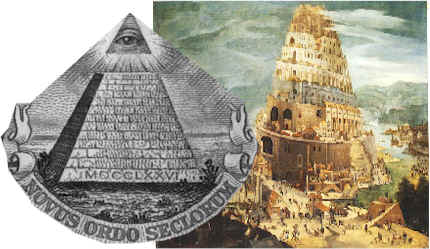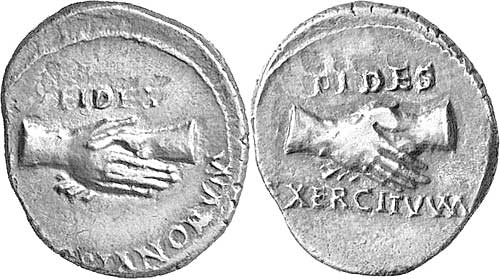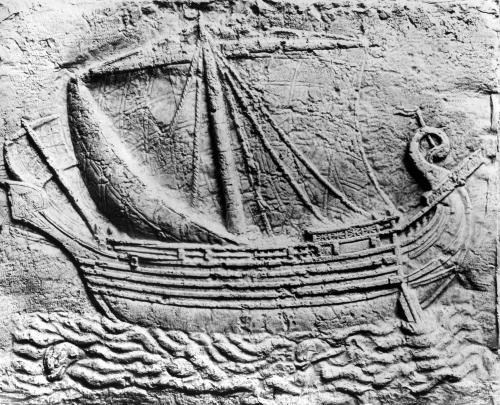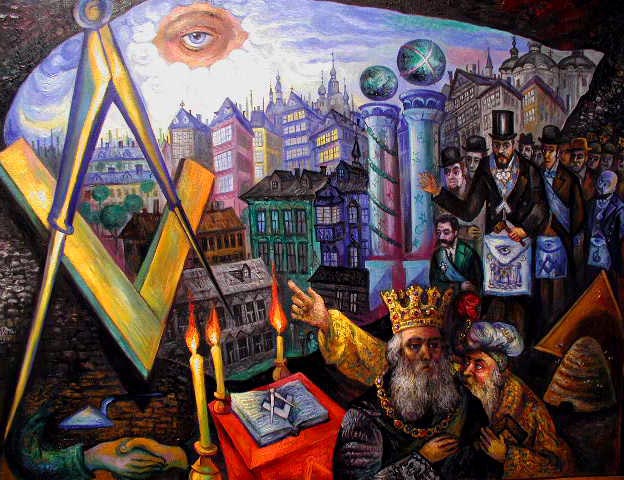by Moe | Nov 12, 2015 | Freemasonry
 ” Love calling order from Chaos” – Hesiod
” Love calling order from Chaos” – Hesiod
According to the bible, Nimrod is the son of Cush, Grandson of Ham and great-grandson of Noah. The names Nimrod and Cush have dual meanings. The meanings for Nimrod are “ the leopard who subdues,” “the leopard tamer,” the great hunter, and in Hebrew, spotted. He is often depicted in wearing a garment of a leopard. In the Chaldee, chaos is said to be the pronunciation of Cush and is also written Khus (Chus) and is derived from Khawos (Khaos) or “Chaos.” (more…)
Moe is the founder of GnosticWarrior.com. He is a father, husband, author, martial arts black belt, and an expert in Gnosticism, the occult, and esotericism.
by Moe | Nov 4, 2015 | Freemasonry, History of the Brotherhood
“And Hiram king of Tyre sent messengers to David, and cedar trees, also carpenters and masons who built David a house.” – Samuel 5:11
 In my last couple articles on Hiram, King Hiram: The Masonic Chief Architect from Crete and Hiram’s First Masons: The Cunning Daedalus Invented the Masonic Working Tools, I explained the many connections that exist in the golden thread of time between one of the crafts most honored builders and the ancient Holy Island of Crete. A legend that we can actually piece together using true physical evidence in the geography, archeaology, etymology and history that supports both Biblical and Masonic stories of Hiram.
In my last couple articles on Hiram, King Hiram: The Masonic Chief Architect from Crete and Hiram’s First Masons: The Cunning Daedalus Invented the Masonic Working Tools, I explained the many connections that exist in the golden thread of time between one of the crafts most honored builders and the ancient Holy Island of Crete. A legend that we can actually piece together using true physical evidence in the geography, archeaology, etymology and history that supports both Biblical and Masonic stories of Hiram.
For example in the research I will present to you below, I will show you the very building materials that Hiram had used to build Solomon’s Temple such as the cedars and cyprus trees which can found on Crete. Many great historians have actually said that trees like the cedar had originated there. The same exact wood that archaeologists have discovered in the ruins of the Temple of Knossos on Crete which I know as the true ancient Temple of Solomon.
This takes this research to the next level where it becomes more than just a theory. This is actual Scientific evidence that matches the history, biblical story and masonic legends more than any other location and temple ruins on earth.
There were great forests of cypress in Crete for King Hiram and his Masons to utilize in the building of the Temple.
Some of the world’s greatest philosophers and writers such as Diodorus Siculus, Plato, and Solinus speak of groves of Cypress which were held sacred in Crete, near the ruins of the reputed dwelling of the Goddess Rhea, and in the vicinity of the Cave of Zeus on Mount Ida. The Roman historian and philosopher Pliny had said, that Crete was the first natural habitat for the “cypress trees which sprout spontaneously on Mount Ida on the island of Crete, whenever the soil there is disturbed”. (more…)
Moe is the founder of GnosticWarrior.com. He is a father, husband, author, martial arts black belt, and an expert in Gnosticism, the occult, and esotericism.
by Moe | Oct 27, 2015 | Freemasonry, Meaning of Symbols
“Offer not your right hand easily to everyone” – Pythagoras
33rd Degree Freemason and Sovereign Pontiff of the Scottish Rite, Albert Pike had written tha the clasped hands was another symbol which was used by Pythagoras.
Over time, the handshake of the Gnostic Pythagoreans became the secret Masonic handshake of the Freemasons to announce to fellow Brothers they were followers of the Gnosis. Robert Freke Gold explains this fact in “The History of Freemasonry, Its Antiquities, Symbols …, Volume 1
By Robert Freke Gould
It has been maintained, that the intermediaries in passing ou the “Masonic Grip” from the Ancients to the Moderns, were the followers of the Gnosis, amongst whom symbols and tokens for mutual recognition were well known. At least, so we are informed by Epiphanius, whose early experiences as a Manichean (before his elevation to the episcopate), specially qualify him to enlighten us on this point.
Iamblicus: “The meaning of this symbol is, do not draw up, nor endeavor to raise, by extending your right hand, the unadopted and uninitiated. It also signifies that the right hand is not to be given easily even to those who have for a long time proved themselves worthy of it, through disciplines, and doctrines, and the participation of continence, the quinquennial silence/ and other probationary trials.”‘ It has been maintained, that the intermediaries in passing ou the “Masonic Grip” from the Ancients to the Moderns, were the followers of the Gnosis, amongst whom symbols and tokens for mutual recognition were well known. At least, so we are informed by Epiphanius, whose early experiences as a Manichean (before his elevation to the episcopate), specially qualify him to enlighten us on this point. On the arrival of any stranger, he says, belonging to the same belief, they have a sign given by the man to the woman, and vice versd. In holding out the hand, under pretence of saluting each other, they feel it and tickle it in a particular manner underneath the palm, and so discover if the new comer belongs to the same sect.’
At least, so we are informed by Epiphanius, whose early experiences as a Manichean (before his elevation to the episcopate), specially qualify him to enlighten us on this point. On the arrival of any stranger, he says, belonging to the same belief, they have a sign given by the man to the woman, and vice versd. In holding out the hand, under pretence of saluting each other, they feel it and tickle it in a particular manner underneath the palm, and so discover if the new comer belongs to the same sect.’ The preferable opinion, however, would seem to be that recognition or salutation by means of a “grip” or “band-shaking” is a common feature of many religious and social systems, and is especially prevalent amongst the Eastern people. To this day the Parsees of Western India, after prayers on Pappati or New Year’s Day, visit their friends and relations, when the Hamma-i-jour or “joining of hands” is performed.’ A symbolic language appears to have existed in the old monasteries, the signs not being optional, but transmitted from antiquity, and taught like the alphabet.”
Pike had written, “It represented the number 10, the sacred number in which all the preceding numbers were contained; the number expressed by the mysterious Tetractys, a figure borrowed by him and the Hebrew priests alike from the Egyptian sacred science, and which ought to be replaced among the symbols of the Masters degree, where it of right belongs. (more…)
Moe is the founder of GnosticWarrior.com. He is a father, husband, author, martial arts black belt, and an expert in Gnosticism, the occult, and esotericism.
by Moe | Oct 27, 2015 | Freemasonry, History of the Brotherhood
By Bro.’ Albert Pike – After the destruction of the city and temple, some of the Hebrew initiates were carried away as captives into  Assyria ; others escaped into Egypt, Persia, Phoenica, Syria, the desert of the Thebald, and even into Greece, Etruria and India.
Assyria ; others escaped into Egypt, Persia, Phoenica, Syria, the desert of the Thebald, and even into Greece, Etruria and India.
At a later day, in Phoenician vessels, they penetrated into England, Scotland, and Ireland and other European regions. (more…)
Moe is the founder of GnosticWarrior.com. He is a father, husband, author, martial arts black belt, and an expert in Gnosticism, the occult, and esotericism.
by Moe | Oct 26, 2015 | Freemasonry, History of the Brotherhood
And from each pilgrim this be heard, As from one humble voice to-day: “Honor to Hiram,—Masons’ lord, “Honor and gratitude we pay!”
The Masonic King Hiram (Huram, CHiram) is a Phoenician who hailed from the ancient holy Island of Crete in the time of Ramesses II and III. Crete was the main home political and Navy base for the ancient Phoenicians for thousands of years, and today we can find the remnants of the first and second Temple of Solomon in ruins at the ancient city of Gnosis, also known as Knossos.
At the time of Hiram and Phoenician rule, It was a mountainous island covered with forests of cedar, cypress, oak, and fir that provided the necessary materials to build Solomon’s Temple, and plenty of skilled Masons, metal workers and mercenary soldiers to complete the job. In fact, there is no other place or people in the history world that would have had the man power with the skills, materials and ships to carry out such a monumental task. We not only have to study history and the scientific evidence to discover who King Hiram was and what country he was from, we also have to use basic common sense and reasoning.
The name of Crete and the surrounding lands they controlled was once called Phoenicia and the people Phoenicians by their cousins who came later, the Greeks. In the Scripture, they are called many names such as the Sidonians, Cretans, Hebrews, Philistines and Canaanites. They called themselves Canaanites from Sidonia. The meaning of the word Canaanite is merchant and it is no secret that they were some of the most well known and traveled merchants that the world has ever known for thousands of years. In fact, they are credited with giving birth to Western civilization which is said to be born on the Holy Island of Crete. (more…)
Moe is the founder of GnosticWarrior.com. He is a father, husband, author, martial arts black belt, and an expert in Gnosticism, the occult, and esotericism.
by Moe | Sep 29, 2015 | Freemasonry
(By Freemason, Gnostic and author, Hank Kraychir) – In my personal quest to discover as much about English Masonic history as I can, I came across a book written by Reverend George Oliver, it’s called, Masonic Library, the Antiquities of Freemasonry (1854). Within the book, I found a chronological list of Grand Masters and Patrons of Masonry in England, which just so happened to date it back to 557 AD ~ an important date I had written about earlier. (more…)
Moe is the founder of GnosticWarrior.com. He is a father, husband, author, martial arts black belt, and an expert in Gnosticism, the occult, and esotericism.
 ” Love calling order from Chaos” – Hesiod
” Love calling order from Chaos” – Hesiod




